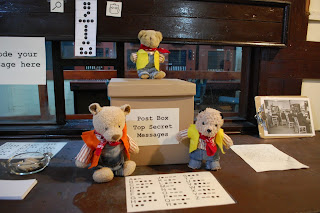When we were on our way home along the Cheshire canals out of Manchester, we stopped overnight in a town called Lymm. I liked the attractive old town, with its bakery full of tasty things and so did Hanley Bear, because Polar and Grizzly found a pack of oatcakes for sale in the Co-op.
Hanley, who had been feeling homesick, wanted to eat them for a mid-morning snack but Grizzly said they were for supper, after an afternoon cruising into Runcorn.
'Are we going on the River Weaver again?' I asked. Grizzly explained that we weren't as, this time, we were taking an arm of the Bridgewater Canal that went there.
It was very quiet along the Runcorn Arm, with very few other boats on the move. When we stopped, outside a big theatre building, Hanley helped Polar to make cheese and tomato oatcakes for supper.
In the morning, we set off on the train for Liverpool. This time, we were promised a proper look around the city.
The first place Grizzly and Polar took us to was the Western Approaches Museum in Rumford Street, to learn about the Battle of the Atlantic in the Second World War and to see the work done by Mrs Sue and Mr Alfred, human guardians of our friends the Vaarks.
Polar and Grizzly got special passes to visit from a lady called Carmel, before going down several flights of concrete steps into the underground museum.
We made our way through some cold, echoing corridors, reading about the dangerous times during the war when it was in use, until we suddenly found ourselves in a huge, high room with a vast map on the wall.'What a funny map,' said Endon. 'Most of it is the sea!'
Grizzly explained that was because it was for plotting where convoys of ships were moving about, and where there were reports of enemy submarines trying to sink them.
Using old telephones, you could listen to recordings of people who had worked there talking about their experiences. Most of them were young women who had joined the navy, known as 'Wrens'. They were very brave, as they had to come to work even when the city was being bombed and they had to keep what they were doing secret, even from their families.
We found secret files to read on some of the desks. I wondered if I was supposed to tidy them away in this box, but Polar said they were only secret during the war and they should be left out for everyone to see now.
We went into the offices were the commanding officers could keep watch on all the work going on and see where there was danger to the ships and likely to be a battle.
We got special stamps in our passes as we moved on to other parts of the bunker. In one office, I tried typing on an old typewriter. It was easier to pick out the right letter than using a computer keyboard but needed much more effort.
In one of the dormitories, up on the top bunk, we found a fellow bear, who whose job was to make sure that human cubs visiting the museum didn't find it too scary. We hoped the Wrens had small bears to given them hugs during air-raids or when they were worried about sea battles and secrets.
In the radio room, we had a go at learning Morse Code, which is easier to do with paws than typing but takes just as long, as most letters are made up of several dots and dashes. We wrote a secret message for the museum people and put it in the box for them.
We had almost reached the end of our visit. Endon put the last stamps on our passes and we followed Polar and Grizzly to a room where there was tea and biscuits.
Suddenly, we found ourselves in a 1940s street, with tape on the windows, rationing in the shops and a big unexploded bomb!
'Did this whole street fall down a bomb crater during the war?' asked little Endon.
'No,' said Hanley. 'It was all made by Mr Alfred and Mrs Sue. Come and take a close look at the bomb!'
We climbed up on the big, black bomb. We were relieved to hear no ticking or other noises coming from it. 'I'm sure the Vaarks helped to make things,' I added. 'Fury Vaark is very practical.'
We had fun sliding down the bomb, although we wouldn't have been silly enough to do that if it was a real one. Then we went to explore the shops. There was another museum bear watching us from one of the windows, looking after jars of sweets. We weren't allowed any, as we didn't have ration cards for them, so instead we played see-saw on the scales.Polar and Grizzly came to collect us after they had their cups of tea. We didn't really want to leave the 1940s street, as we kept finding more clever little details and interesting things made by our clever friends, but Polar told us we had another special treat coming up, so we jumped back into our bag and set off for the next part of our Liverpool adventure.

































































